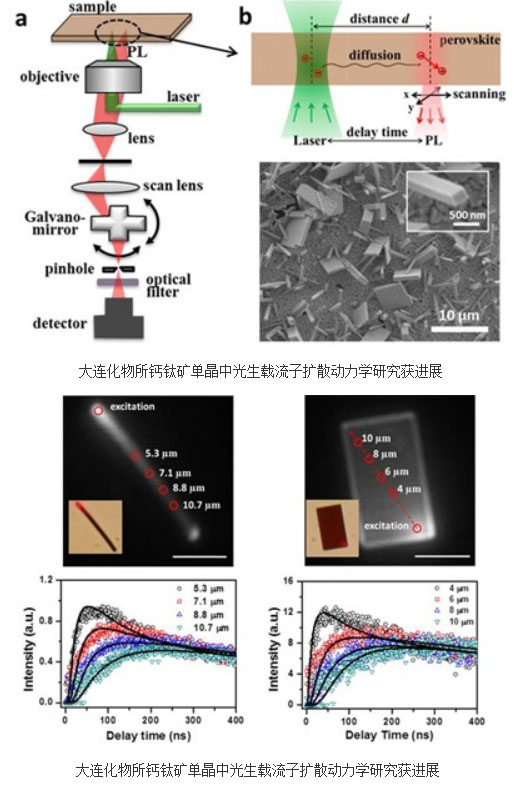
Recently, the research team led by Jin Shengji, a researcher of the Ultrafast Time-Resolved Spectroscopy and Dynamics Innovation Research Group (11T5 Group) of the Dalian Institute of Chemical Physics, Chinese Academy of Sciences, has organized photocatalyst carrier diffusion in organo-organo-perovskite single crystals. New progress was made in the kinetic research work and the visualization and quantitative study of the carrier diffusion process in single perovskite single crystal nanowires/nanoplates was successfully achieved. The relevant research results were published online in the American Chemical Society (DOI: 10.1021/jacs.5b08045.) with the topic of Visualizing Carrier Diffusion in Individual Single-Crystal Organolead Halide Perovskite Nanowires and Nanoplates.
In recent years, the metal organic perovskite material CH3NH3PbX3 (X=Cl, Br, I) has shown great application value in the construction of high-efficiency, low-cost solar cells and other optoelectronic devices, and has become an internationally important research hotspot. One of the materials. Such perovskite nanostructure materials (such as nanowires and nanosheets), while retaining superior photophysical properties, their micronano size also makes this material has a wide range of applications in the field of micro-optoelectronic/optical devices. The excellent performance of CH3NH3PbX3 materials in various devices is due to its unique photophysical properties such as high carrier lifetime, high charge mobility and long migration distance. Therefore, the qualitative and quantitative determination of these photophysical parameters is an important means for people to determine the quality of perovskite samples.
The lifetime of a carrier can be simply deduced from the detection of carrier fluorescence lifetime, but the measurement of charge mobility (or migration coefficient) often requires the electrode material to be loaded on a perovskite sample. However due to sample size limitations, electrodes are loaded on perovskite nanostructured materials (eg, nanowires, nanosheets, etc., hundreds of nanometers to several micrometers in size) or using conventional analytical methods such as transient absorption microscopy and time resolution. Tera-Hz, etc.) detection is extremely difficult, which makes it impossible to determine the charge transport properties of perovskite nanostructure materials. The research team successfully achieved direct fluorescence of the photocarriers in the perovskite single crystal nanowires and nanoplatelets without changing the morphology of the sample by constructing a fluorescence scanning time-resolved fluorescence imaging system ingeniously. Imaging. While observing the kinetics of charge transport, quantitative information on carrier lifetime, charge transfer constant/mobility, and carrier migration distance can be obtained for perovskite samples.
In addition, using this detection method, the research group obtained statistical analysis of the results of a large number of perovskite nanostructure materials. It was found that although they are monocrystalline, the charge mobility and other properties of different nanowires/nanosheets can still be exhibited. There is a huge difference, and this difference is not related to the size or shape of the sample. Therefore, in the process of constructing devices using these nanomaterials, it is very necessary to rapidly screen the properties of the sample. The detection method established by the research group not only provides carrier kinetics information for basic research related to such materials, but also has great promise for application to the study of charge transfer kinetics of other photoelectric materials.
The above research was supported by the National Natural Science Foundation of China.
Flame Retardant Suits,Flame Resistant Suits,Fire Retardant Suits,Fire Resistant Suits
Xinxiang Worldbest Patron Saint Co., Ltd , https://www.xxhyhsworkwear.com
